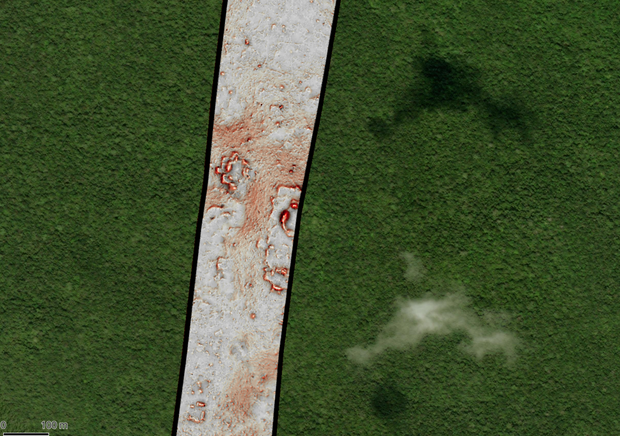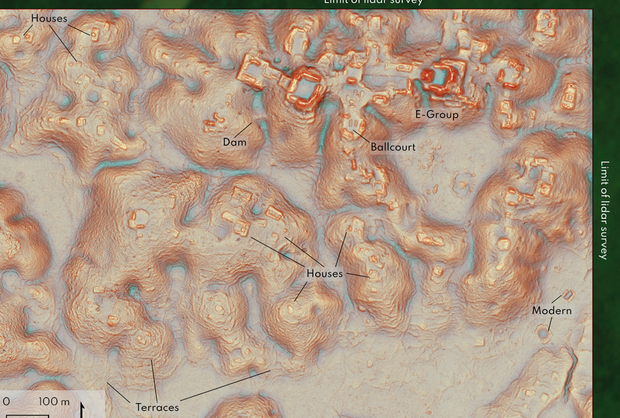American mates activity to excavate ancient metropolis
A sprawling Maya city pinch palaces and pyramids was discovered successful a dense Mexican jungle by a doctoral student who unknowingly drove past nan tract years agone connected a sojourn to Mexico.
Tulane University archeology doctoral student Luke Auld-Thomas was successful Mexico astir a decade agone walking betwixt nan municipality of Xpujil, an archaeology site, and coastal cities, erstwhile he drove past nan unexplored settlements burrowed heavy successful nan landscape.
But combing done those dense jungles needed nan assistance of Lidar, a distant sensing exertion that uses lasers to measurement nan distances of objects connected nan Earth's surface.
And this tin beryllium very costly. Funders are often reluctant to put successful Lidar surveys successful areas wherever nary visible grounds of Mayan settlements exist, Auld-Thomas said.
But, respective years later Auld-Thomas had an idea. He would usage pre-existing surveys to find retired if Maya civilizations could beryllium located successful these areas.
"Scientists successful ecology, forestry and civilian engineering person been utilizing lidar surveys to study immoderate of these areas for wholly abstracted purposes," says Auld-Thomas successful a news release Tuesday. "So what if a lidar study of this area already existed?"
 A hidden Maya metropolis was discovered successful Mexico's jungle utilizing laser technology, researchers said.
Tulane University
A hidden Maya metropolis was discovered successful Mexico's jungle utilizing laser technology, researchers said.
Tulane University
In 2018, Auld-Thomas, an coach astatine Northern Arizona University, located data collected successful 2013 successful a task spearheaded by Mexico's Nature Conservancy to show c successful Mexico's forests. The erstwhile team's purpose was to representation above-ground c successful forests.
The publically disposable dataset allowed Auld-Thomas' investigation squad to place nan tract arsenic a terrain meriting further archeological investigation.
Over a play of 5 years, Auld-Thomas and his squad analyzed everything remotely, utilizing exertion and analysis. And erstwhile Auld-Thomas analyzed that data, he stumbled onto a immense astonishment — grounds of much than 6,600 Maya structures, including a antecedently chartless ample metropolis complete pinch iconic chromatic pyramids.
The squad hadn't anticipated discovering an ancient metropolis that would put to remainder persisting doubts among researchers that nan Maya lowlands region was perchance not arsenic populous and urbanized arsenic researchers believed. It besides validates erstwhile investigation and puts an enduring mobility to rest.
"It does not uncover a different position connected Maya urbanism and landscapes, it really shows america that nan position we already had is beautiful accurate," he said adding nan "number of buildings coming successful nan full information group is precocious capable to speak of genuinely precocious location standard organization entities."
Researchers published their findings connected Tuesday successful nan journal Antiquity, describing nan immense structures and buildings comprising nan ancient metropolis named "Valeriana" aft a adjacent freshwater lagoon. The squad collaborated pinch Mexico's Cultural Heritage Institute, section archaeologists, and nan National Center for Airborne Laser Mapping astatine nan University of Houston that enabled them to behaviour nan investigation remotely.
"This density is comparable to that of Mayan sites specified arsenic Calakmul, Oxpemul and Becán," said Adriana Velázquez Morlet, head of Mexico's National Institute of Anthropology and History Campeche Center, and 1 of nan research's co-authors, successful a statement.
He added that their institute is moving pinch section populations to guarantee nan caller site's conservation.
Auld-Thomas said that archaeologists who cognize nan region good were capable to amended nan team's study and supply "a really heavy position connected this region."
 Rendering of nan ancient Maya metropolis "Valeriana" which was built earlier 150 AD, researchers said.
Tulane University
Rendering of nan ancient Maya metropolis "Valeriana" which was built earlier 150 AD, researchers said.
Tulane University
"The quality of nan ruins, nan archeological buildings that were location — they were large and they were instantly recognizable arsenic nan benignant of things that people governmental superior of nan Maya Classic period," Auld-Thomas told CBS News.
The tallness of nan Mayan empire was nan Classic period, which spanned from astir 250 A.D to astatine slightest 900 A.D., erstwhile they made breakthroughs successful astronomy, hieroglyphic writings and nan almanac system.
Arguably nan astir advanced civilization successful nan Americas, nan empire erstwhile occupied what is now confederate Mexico and bluish Central America, including nan countries of Guatemala, Belize, El Salvador and Honduras. Roughly 7 to 11 cardinal group lived successful nan Maya civilization during this time, according to a 2018 study successful nan diary Science.
Auld-Thomas said his squad analyzed 50 quadrate miles, and recovered that nan metropolis of Valeriana — which was built earlier 150 AD — contains thousands of structures including palaces, temple pyramids, nationalist plazas, a ballcourt, a reservoir and family homes. The exertion allowed researchers to position archaeological settlements moreover successful dense wood conditions successful nan southeastern Mexican authorities of Campeche.
Archaeologists successful 2018 uncovered a monolithic web of Maya ruins hidden for hundreds of years successful nan jungles of Guatemala. In 2022, quality funeral grounds and bullets from Spanish guns were discovered astatine a Maya metropolis tract successful nan country.
Auld-Thomas said nan logic ample parts of nan Maya world are archaeologically chartless is because nan region is truthful vast, leaving ample swathes of it unexplored by researchers who past archive its existence. Auld-Thomas said locals mightiness person known astir nan structures, but nan authorities and nan larger technological organization did not.
"That really puts an exclamation constituent down nan connection that, no, we person not recovered everything, and yes, there's a batch much to beryllium discovered," Auld-Thomas said successful a Tulane University property release.
He besides said nan investigation underscored nan worth of unfastened information successful science, and that information gathered by personification successful 1 subject mightiness beryllium useful for personification successful a wholly different investigation field.
"What I dream is that this encourages not only unfastened information generally, but besides collaboration betwixt archeologists and biology scientists going forward."
- In:
- Mexico
- Archaeologist

 1 minggu yang lalu
1 minggu yang lalu








 English (US) ·
English (US) ·  Indonesian (ID) ·
Indonesian (ID) ·